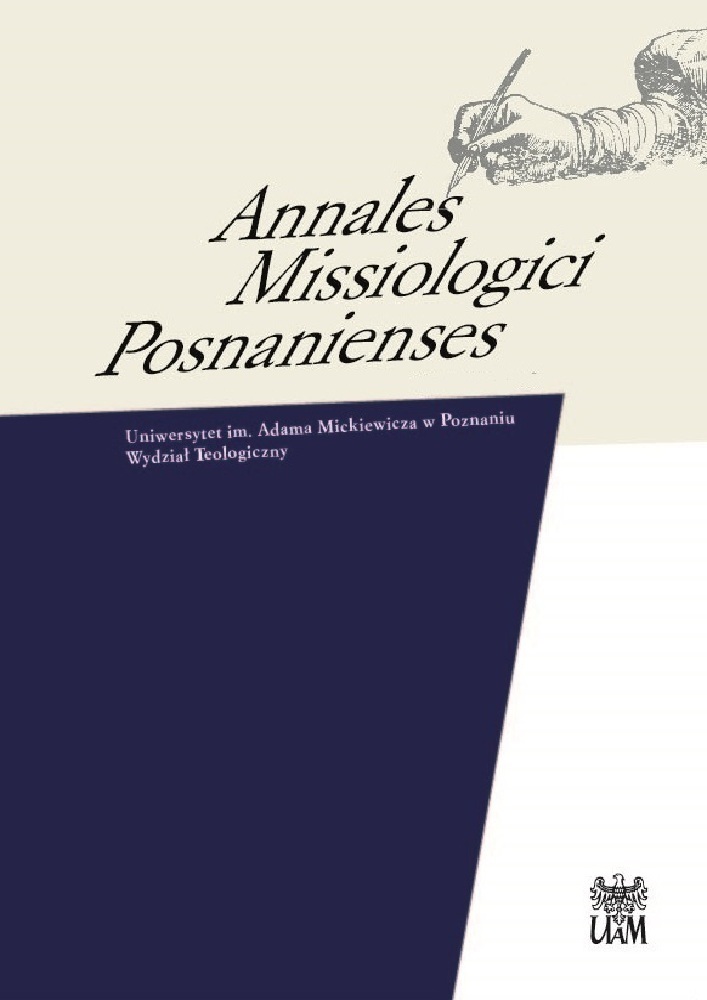Abstrakt
The Polish missionary media of social communication has been appearing since 1882. In the analyzed period, they performed their role very well in the period of the covid-19 pandemic. They quickly reacted to a crisis situation, informing about it fairly and widely, and in some titles it translated into inviting readers to spiritual and material commitment to specific needs. A special tool in this is the media communicating via the Internet, especially social media, which allow for immediate information and reactions to a short- or long-term crisis situation. The study shows that the publishing functions performed by this press include: informational and journalistic, promoting the mission and the missionary idea, catechetical and formation, new evangelization and evangelization, fundraising for the mission, awakening missionary vocations, organizing mission groups, opinion-forming and attitude-forming. It seems that in the main assumptions, the implementation of these functions at the level of ideas has not changed, and the differences result primarily from changes in the communication technique and the diversity of target groups. Before starting the research, the following hypotheses and research theses were formulated, which we then tried to verify (hypotheses) or confirm (theses) in the course of the research. Thesis 1: during the covid-19 pandemic, leading mission journals performed the press functions for which they were created – has been confirmed. Hypothesis 1: the press functions performed by the press media and the media communicating via the Internet differed – it was verified negatively. However, it is noticeable that individual media are used based on their technical capabilities (quick information and immediate help was possible through the media communicating via the Internet) and target groups (Internet users are younger and the content was usually prepared with them in mind). Hypothesis 2: the main functions performed were: information, organization and fundraising – in the field of assistance to the publisher’s legal entity – has been positively verified.
Bibliografia
Adamski, Andrzej. Łęcicki, Grzegorz. „Teologia mediów i komunikacji – na styku nauk o mediach oraz nauk teologicznych.” Studia Medioznawcze 65 (2016) 2: 11-24. https://doi.org/10.33077/uw.24511617.ms.2016.65.468 DOI: https://doi.org/10.33077/uw.24511617.ms.2016.65.468
Bertrand, Claude Jean. Deontologia mediów. Tłum. Tomasz Szymański. Warszawa: IW PAX, 2007.
Chyliński, Marek. Russ-Mohl, Stephan. Dziennikarstwo. Warszawa: Wydawnictwo Adam Marszałek, 2019.
Eysenck, Hans Jürgen. The Psychology of Politics. London: Hassell Street Press, 2021.
Kaleta, Andrzej. Polskie katolickie czasopiśmiennictwo misyjne w II Rzeczypospolitej. Kalisz: Wydawnictwo PW Wega, 2001.
Malek, Roman. „Stulecie czasopisma ‘Die Katholischen Missionen’.” Collectanea Theologica 44 (1975): 189-195.
Marody, Mirosława. Sens teoretyczny a sens empiryczny pojęcia postaw, analiza metodologiczna zasad doboru wskaźników w badaniach nad postawami. Warszawa: PWN, 1976.
Mazzei, Luciano. Chiesa e comunicazione. I mass media della Santa Sede. Roma: L’Erma di Bretschneider, 1997.
Młynarz, Kazimierz. Funkcja radia, telewizji i prasy. Poznań: Nurt, 1971.
Nelson, Erland. „Attitudes: Their Nature and Development.” Journal of General Psychology 21 (1939) 2: 367-399. https://doi.org/10.1080/00221309.1939.10544304 DOI: https://doi.org/10.1080/00221309.1939.10544304
Nieć, Mateusz. Komunikowanie społeczne i media. Perspektywa politologiczna. Warszawa: Wolters Kluwer Polska, 2010.
Nowak, Marian. Podstawy pedagogiki otwartej. Ujęcie dynamiczne w inspiracji chrześcijańskiej. Lublin: Wydawnictwo KUL, 1999.
Pisarek, Walery. Wstęp do nauki o komunikowaniu. Warszawa: Wydawnictwa Akademickie i Profesjonalne, 2008.
Słownik terminologii medialnej. Red. Walery Pisarek. Kraków: Universitas, 2006.
Szulczewski, Michał. O funkcjach i roli prasy w państwie socjalistycznym. Warszawa: Książka i Wiedza, 1964.
Tetelowska, Irena. Szkice prasoznawcze: wybór rozpraw i artykułów. Kraków: Ośrodek Badań Prasoznawczych RSW „Prasa”, 1967.
Thomas, William. Isaac. Znaniecki, Florian. Polish Peasant in Europe and America. Vol. 1. Boston: Paperbackshop Uk Import, 1996.
International Commission for the Study of Communication Problems. One World. Report by the International Commission for the Study of Communications Problems. Paris–London–New York: MacBride Sean UNESCO, 1981.
Wrzos, Marcin. „Od czasopism do Web 3.0. Polskie media misyjne po Vaticanum Secundum. Rozwój środków społecznego przekazu oraz nauczanie Kościoła na ich temat w polskim czasopiśmiennictwie misyjnym.” Cz. 1. Nurt SVD 144 (2018) 2: 85-108.
Wrzos, Marcin. Główne idee teologiczne, historia i funkcje oblackiego czasopiśmiennictwa misyjnego w Polsce (1926-2016). Poznań: Misyjne Drogi, 2016.
Wrzos, Marcin. Misje w polskojęzycznym Internecie. Studium misjologiczno-prasoznawcze. Warszawa: Wydawnictwo Naukowe UKSW i Misyjne Drogi, 2020.
Wrzos, Marcin. Polskie czasopiśmiennictwo misyjne po II wojnie światowej. Studium misjologiczno-prasoznawcze. Poznań: Kuria Prowincjonalna Misjonarzy Oblatów Maryi Niepokalanej, 2013.
Licencja
Prawa autorskie (c) 2021 Marcin Jan Wrzos

Utwór dostępny jest na licencji Creative Commons Uznanie autorstwa – Użycie niekomercyjne – Bez utworów zależnych 4.0 Międzynarodowe.
PRACE PUBLIKOWANE W CZASOPIŚMIE DOSTĘPNE SĄ NA LICENCJI CREATIVE COMMONS:
Przed 2006 do wszystkich tekstów opublikowanych prawa autorskie są zastrzeżone.
Autorzy
Autorzy tekstów przyjętych do publikacji w czasopiśmie Annales Missiologici Posnanienses są zobowiązani do wypełnienia, podpisania i odesłania na adres redakcji umowy o udzielenie nieodpłatnej licencji do utworów ze zobowiązaniem do udzielania sublicencji CC.
Zgodnie z umową, autorzy tekstów opublikowanych w czasopiśmie Annales Missiologici Posnanienses udzielają Uniwersytetowi im. Adama Mickiewicza w Poznaniu niewyłącznej i nieodpłatnej licencji Creative Commons Attribution-NonCommercial-NoDerivatives 4.0 International (CC BY-NC-ND 4.0) oraz zezwalają na sublicencje na tych samych warunkach.
Autorzy zachowują prawa do dalszego, swobodnego rozporządzania utworem.
Użytkownicy
Zainteresowani użytkownicy internetu uprawnieni są do korzystania z utworów opublikowanych od 2021 roku w Annales Missiologici Posnanienses pod następującymi warunkami:
- uznanie autorstwa – obowiązek podania wraz z rozpowszechnionym utworem, informacji, o autorstwie, tytule, źródle (odnośniki do oryginalnego utworu, DOI) oraz samej licencji;
- użycie niekomercyjne – nie należy wykorzystywać utworu do celów komercyjnych;
- bez tworzenia utworów zależnych – utwór musi być zachowany w oryginalnej postaci, nie można bez zgody twórcy rozpowszechniać np. tłumaczeń, opracowań.
Zainteresowani użytkownicy internetu uprawnieni są do korzystania z utworów opublikowanych w latach 2006-2020 w Annales Missiologici Posnanienses pod następującymi warunkami:
- uznanie autorstwa – obowiązek podania wraz z rozpowszechnionym utworem, informacji, o autorstwie, tytule, źródle (odnośniki do oryginalnego utworu, DOI) oraz samej licencji;
- bez tworzenia utworów zależnych – utwór musi być zachowany w oryginalnej postaci, nie można bez zgody twórcy rozpowszechniać np. tłumaczeń, opracowań.
Inne
Uniwersytet im. Adama Mickiewicza w Poznaniu zachowuje prawo do czasopisma jako całości (układ, forma graficzna, tytuł, projekt okładki, logo itp.).



